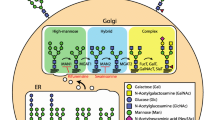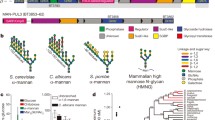Abstract
Multiple species of cellular slime mold (CSM) amoebae share overlapping subterranean environments near the soil surface. Despite similar life-styles, individual species form independent starvation-induced fruiting bodies whose spores can renew the life cycle. N-glycans associated with the cell surface glycocalyx have been predicted to contribute to interspecific avoidance, resistance to pathogens, and prey preference. N-glycans from five CSM species that diverged 300–600 million years ago and whose genomes have been sequenced were fractionated into neutral and acidic pools and profiled by MALDI-TOF-MS. Glycan structure models were refined using linkage specific antibodies, exoglycosidase digestions, MALDI-MS/MS, and chromatographic studies. Amoebae of the type species Dictyostelium discoideum express modestly trimmed high mannose N-glycans variably modified with core α3-linked Fuc and peripherally decorated with 0–2 residues each of β-GlcNAc, Fuc, methylphosphate and/or sulfate, as reported previously. Comparative analyses of D. purpureum, D. fasciculatum, Polysphondylium pallidum, and Actyostelium subglobosum revealed that each displays a distinctive spectrum of high-mannose species with quantitative variations in the extent of these modifications, and qualitative differences including retention of Glc, mannose methylation, and absence of a peripheral GlcNAc, fucosylation, or sulfation. Starvation-induced development modifies the pattern in all species but, except for universally observed increased mannose-trimming, the N-glycans do not converge to a common profile. Correlations with glycogene repertoires will enable future reverse genetic studies to eliminate N-glycomic differences to test their functions in interspecific relations and pathogen evasion.








Similar content being viewed by others
Abbreviations
- 2-AB:
-
2-aminobenzamide
- ACN:
-
Acetonitrile
- CSM:
-
Cellular slime mold
- DTT:
-
Dithiothreitol
- H8N4F:
-
Notation for a glycan containing 8 hexoses, 4 HexNAc residues, and 1 deoxyHex expected to be fucose
- TFA:
-
Trifluoroacetic acid
References
Schaap, P.: Evolutionary crossroads in developmental biology: Dictyostelium discoideum. Development 138, 387–396 (2011)
Heidel, A.J., Lawal, H.M., Felder, M., Schilde, C., Helps, N.R., Tunggal, B., Rivero, F., John, U., Schleicher, M., Eichinger, L., Platzer, M., Noegel, A.A., Schaap, P., Glöckner, G.: Phylogeny-wide analysis of social amoeba genomes highlights ancient origins for complex intercellular communication. Genome Res. 21, 1882–1891 (2011)
Sucgang, R., Kuo, A., Tian, X., Salerno, W., Parikh, A., Feasley, C.L., Dalin, E., Tu, H., Huang, E., Barry, K., Lindquist, E., Shapiro, H., Bruce, D., Schmutz, J., Salamov, A., Fey, P., Gaudet, P., Anjard, C., Babu, M.M., Basu, S., Bushmanova, Y., van der Wel, H., Katoh-Kurasawa, M., Dinh, C., Coutinho, P.M., Saito, T., Elias, M., Schaap, P., Kay, R.R., Henrissat, B., Eichinger, L., Rivero, F., Putnam, N.H., West, C.M., Loomis, W.F., Chisholm, R.L., Shaulsky, G., Strassmann, J.E., Queller, D.C., Kuspa, A., Grigoriev, I.V.: Comparative genomics of the social amoebae Dictyostelium discoideum and Dictyostelium purpureum. Genome Biol. 12, R20 (2011)
Dykstra, M.J., Aldrich, H.C.: Successful demonstration of an elusive cell coat in amebae. J. Protozool. 25, 38–41 (1978)
Freeze, H.H.: Dictyostelium discoideum glycoproteins: using a model system for organismic glycobiology. In: Glycoproteins II. Eds.: Montreuil, J.F.G. Vliegenthart and H. Schachter, Elsevier Science B.V. pp. 89–121 (1997)
Feasley, C.L., Johnson, J.M., West, C.M., Chia, C.P.: Glycopeptidome of a heavily N-glycosylated cell surface glycoprotein of Dictyostelium implicated in cell adhesion. J. Proteome Res. 9, 3495–3510 (2010)
Schiller, B., Hykollari, A., Voglmeir, J., Pöltl, G., Hummel, K., Razzazi-Fazeli, E., Geyer, R., Wilson, I.B.: Development of Dictyostelium discoideum is associated with alteration of fucosylated N-glycan structures. Biochem. J. 423, 41–52 (2009)
Hykollari, A., Balog, C.I., Rendić, D., Braulke, T., Wilson, I.B., Paschinger, K.: Mass spectrometric analysis of neutral and anionic N-glycans from a Dictyostelium discoideum model for human congenital disorder of glycosylation CDG IL. J. Proteome Res. 12, 1173–1187 (2013)
Sharkey, D.J., Kornfeld, R.: Developmental regulation of asparagine linked oligosaccharide synthesis in Dictyostelium discoideum. J. Biol. Chem. 266, 18485–18497 (1991)
Nicol, A., Garrod, D.R.: Mutual cohesion and cell sorting-out among four species of cellular slime moulds. J. Cell Sci. 32, 377–387 (1978)
Sathe, S., Khetan, N., Nanjundiah, V.: Interspecies and intraspecies interactions in social amoebae. J. Evol. Biol. 27, 349–362 (2014)
Nasser, W., Santhanam, B., Miranda, E.R., Parikh, A., Juneja, K., Rot, G., Dinh, C., Chen, R., Zupan, B., Shaulsky, G., Kuspa, A.: Bacterial discrimination by dictyostelid amoebae reveals the complexity of ancient interspecies interactions. Curr. Biol. 23, 862–872 (2013)
Champion, A., Griffiths, K., Gooley, A.A., Gonzalez, B.Y., Gritzali, M., West, C.M., Williams, K.L.: Immunochemical, genetic and morphological comparison of fucosylation mutants of Dictyostelium discoideum. Microbiology 141, 785–797 (1995)
Houle, J., Balthazar, J., West, C.M.: A glycosylation mutation affects cell fate in chimeras of Dictyostelium discoideum. Proc. Natl. Acad. Sci. U. S. A. 86, 3679–3683 (1989)
West, C.M.: Comparative analysis of spore coat formation, structure, and function in Dictyostelium. Int. Rev. Cytol. 222, 237–293 (2003)
Wang, F., Metcalf, T., van der Wel, H., West, C.M.: Initiation of mucin-type O-glycosylation in Dictyostelium is homologous to the corresponding step in animals and is important for spore coat function. J. Biol. Chem. 278, 51395–51407 (2003)
Bush, J.M., Ebert, D.L., Cardelli, J.A.: Alterations to N-linked oligosaccharides which affect intracellular transport rates and regulated secretion but not sorting of lysosomal acid phosphatase in Dictyostelium discoideum. Arch. Biochem. Biophys. 283, 158–166 (1990)
Souza, G.M., Mehta, D.P., Lammertz, M., Rodriguez-Paris, J., Wu, R., Cardelli, J.A., Freeze, H.H.: Dictyostelium lysosomal proteins with different sugar modifications sort to functionally distinct compartments. J. Cell Sci. 110, 2239–2248 (1997)
West, C.M., Wang, Z.A., van der Wel, H.: A cytoplasmic prolyl hydroxylation and glycosylation pathway modifies Skp1 and regulates O2-dependent development in Dictyostelium. Biochim. Biophys. Acta. 1800, 160–171 (2010)
Zhang, D., van der Wel, H., Johnson, J.M., West, C.M.: Skp1 prolyl 4-hydroxylase of Dictyostelium mediates glycosylation-independent and -dependent responses to O2 without affecting Skp1 stability. J. Biol. Chem. 287, 2006–2016 (2012)
Feasley, C.L., Hykollari, A., Paschinger, K., Wilson, I.B., West, C.M.: N-glycomic and -glycoproteomic studies in the social amoebae. Meth. Mol. Biol. 983, 205–229 (2013)
Hykollari, A., Dragosits, M., Rendić, D., Wilson, I.B., Paschinger, K.: N-glycomic profiling of a glucosidase II mutant of Dictyostelium discoideum by “off-line“ liquid chromatography and mass spectrometry. Electrophoresis 35, 2116–2129 (2014)
Basu, S., Fey, P., Pandit, Y., Dodson, R., Kibbe, W.A., Chisholm, R.L.: DictyBase 2013: integrating multiple Dictyostelid species. Nucleic Acids Res. 41(Database issue), D676–D683 (2013)
Romeralo, M., Skiba, A., Gonzalez-Voyer, A., Schilde, C., Lawal, H., Kedziora, S., Cavender, J.C., Glöckner, G., Urushihara, H., Schaap, P.: Analysis of phenotypic evolution in Dictyostelia highlights developmental plasticity as a likely consequence of colonial multicellularity. Proc. Biol. Sci. 280, 20130976 (2013)
Fey, P., Kowal, A.S., Gaudet, P., Pilcher, K.E., Chisholm, R.L.: Protocols for growth and development of Dictyostelium discoideum. Nat. Protoc. 2, 1307–1316 (2007)
Kang, P., Mechref, Y., Novotny, M.V.: High-throughput solid-phase permethylation of glycans prior to mass spectrometry. Rapid Commun. Mass Spectrom. 22, 721–734 (2008)
Khoo, K.H., Yu, S.Y.: Mass spectrometric analysis of sulfated N- and O-glycans. Meth. Enzymol. 478, 3–26 (2010)
Damerell, D., Ceroni, A., Maass, K., Ranzinger, R., Dell, A., Haslam, S.M.: The GlycanBuilder and GlycoWorkbench glycoinformatics tools: updates and new developments. Biol. Chem. 393, 1357–1362 (2012)
Barker, M.K., Wilkinson, B.L., Faridmoayer, A., Scaman, C.H., Fairbanks, A.J., Rose, D.R.: Production and crystallization of processing α-glucosidase I: Pichia pastoris expression and a two-step purification toward structural determination. Protein Expr. Purif. 79, 96–101 (2011)
Dhanawansa, R., Faridamoayer, A., van der Merwe, G., Li, Y.X., Scaman, C.H.: Overexpression, purification, and partial characterization of Sacchromyces cerevisiae processing alpha-glucosidase I. Glycobiology 12, 229–234 (2002)
West, C.M., van der Wel, H., Coutinho, P.M., Henrissat, B.: Glycosyltransferase genomics in Dictyostelium discoideum. In: Dictyostelium Genomics. Eds.: Loomis, W.F., and Kuspa, A. (Horizon Scientific Press, Norfolk, UK) pp. 235–264 (2005)
Couso, R., van Halbeek, H., Reinhold, V., Kornfeld, S.: The high mannose oligosaccharides of Dictyostelium discoideum glycoproteins contain a novel intersecting N-acetylglucosamine residue. J. Biol. Chem. 262, 4521–4527 (1987)
Sharkey, D.J., Kornfeld, R.: Identification of an N-acetylglucosaminyltransferase in Dictyostelium discoideum that transfers an intersecting N-acetyl glucosamine residue to high mannose oligosaccharides. J. Biol. Chem. 264, 10411–10419 (1989)
Srikrishna, G., Wang, L., Freeze, H.H.: Fucose-beta-1-P-Ser is a new type of glycosylation: using antibodies to identify a novel structure in Dictyostelium discoideum and study multiple types of fucosylation during growth and development. Glycobiology 8, 799–811 (1998)
Nakagawa, M., Tojo, H., Fujii, S.: A glycan of Psi-factor from Dictyostelium discoideum contains a bisecting-GlcNAc, an intersecting-GlcNAc, and a core α-1,6-fucose. Biosci. Biotechnol. Biochem. 75, 1964–1970 (2011)
Knecht, D.A., Dimond, R.L.: Lysosomal enzymes possess a common antigenic determinant in the cellular slime mold, Dictyostelium discoideum. J. Biol. Chem. 256, 3564–3575 (1981)
Schiller, B., Makrypidi, G., Razzazi-Fazeli, E., Paschinger, K., Walochnik, J., Wilson, I.B.: Exploring the unique N-glycome of the opportunistic human pathogen Acanthamoeba. J. Biol. Chem. 287, 43191–43204 (2012)
Magnelli, P., Cipollo, J.F., Ratner, D.M., Cui, J., Kelleher, D., Gilmore, R., Costello, C.E., Robbins, P.W., Samuelson, J.: Unique Asn-linked oligosaccharides of the human pathogen Entamoeba histolytica. J. Biol. Chem. 283, 18355–18364 (2008)
Buser, R., Lazar, Z., Käser, S., Künzler, M., Aebi, M.: Identification, characterization, and biosynthesis of a novel N-glycan modification in the fruiting body of the basidiomycete Coprinopsis cinerea. J. Biol. Chem. 285, 10715–10723 (2010)
Freeze, H.H., Bush, J.M., Cardelli, J.: Biochemical and genetic analysis of an antigenic determinant found on N-linked oligosaccharides in Dictyostelium. Dev. Genet. 11, 463–472 (1990)
Cardelli, J.A., Bush, J.M., Ebert, D., Freeze, H.H.: Sulfated N-linked oligosaccharides affect secretion but are not essential for the transport, proteolytic processing, and sorting of lysosomal enzymes in Dictyostelium discoideum. J. Biol. Chem. 265, 8847–8853 (1990)
Qian, Y., West, C.M., Kornfeld, S.: UDP-GlcNAc:Glycoprotein N-acetylglucosamine-1-phosphotransferase mediates the initial step in the formation of the methylphosphomannosyl residues on the high mannose oligosaccharides of Dictyostelium discoideum glycoproteins. Biochem. Biophys. Res. Commun. 393, 678–681 (2011)
Cipollo, J.F., Awad, A.M., Costello, C.E., Hirschberg, C.B.: N-Glycans of Caenorhabditis elegans are specific to developmental stages. J. Biol. Chem. 280, 26063–26072 (2005)
Gutternigg, M., Bürgmayr, S., Pöltl, G., Rudolf, J., Staudacher, E.: Neutral N-glycan patterns of the gastropods Limax maximus, Cepaea hortensis, Planorbarius corneus, Arianta arbustorum and Achatina fulica. Glycoconj. J. 24, 475–489 (2007)
Banerjee, S., Vishwanath, P., Cui, J., Kelleher, D.J., Gilmore, R., Robbins, P.W., Samuelson, J.: The evolution of N-glycan-dependent endoplasmic reticulum quality control factors for glycoprotein folding and degradation. Proc. Natl. Acad. Sci. U. S. A. 104, 11676–11681 (2007)
Schiller, B., Hykollari, A., Yan, S., Paschinger, K., Wilson, I.B.: Complicated N-linked glycans in simple organisms. Biol. Chem. 393, 661–673 (2012)
Funk, V.A., Thomas-Oates, J.E., Kielland, S.L., Bates, P.A., Olafson, R.W.: A unique, terminally glucosylated oligosaccharide is a common feature on Leishmania cell surfaces. Mol. Biochem. Parasitol. 84, 33–48 (1997)
Hirose, S., Benabentos, R., Ho, H.I., Kuspa, A., Shaulsky, G.: Self-recognition in social amoebae is mediated by allelic pairs of tiger genes. Science 333, 467–470 (2011)
Clarke, M.: Recent insights into host-pathogen interactions from Dictyostelium. Cell. Microbiol. 12, 283–291 (2010)
Varki, A.: Nothing in glycobiology makes sense, except in the light of evolution. Cell 126, 841–845 (2006)
Brock, D.A., Read, S., Bozhchenko, A., Queller, D.C., Strassmann, J.E.: Social amoeba farmers carry defensive symbionts to protect and privatize their crops. Nat. Commun. 4, 2385 (2013)
Erbs, G., Newman, M.A.: The role of lipopolysaccharide and peptidoglycan, two glycosylated bacterial microbe-associated molecular patterns (MAMPs), in plant innate immunity. Mol. Plant Pathol. 13, 95–104 (2012)
Acknowledgments
This project was partially supported by NIH R01-GM037539 and the OCMG, which received funding from the OUHSC Dept. of Biochemistry & Molecular Biology and the OUHSC VP Office for Research. We are grateful to Jennifer Johnson for her technical assistance, the Dictyostelium Stock Center (Northwestern University) and Adam Kuspa (Baylor) for providing cells, and to Christine Scaman (Univ. of British Columbia) for providing yeast α-glucosidase-I.
Conflict of interest
None declared.
Author information
Authors and Affiliations
Corresponding author
Electronic supplementary material
Below is the link to the electronic supplementary material.
ESM 1
(PDF 900 kb)
Rights and permissions
About this article
Cite this article
Feasley, C.L., van der Wel, H. & West, C.M. Evolutionary diversity of social amoebae N-glycomes may support interspecific autonomy. Glycoconj J 32, 345–359 (2015). https://doi.org/10.1007/s10719-015-9592-8
Received:
Revised:
Accepted:
Published:
Issue Date:
DOI: https://doi.org/10.1007/s10719-015-9592-8




